

The Beauty of Uncertainty: How Heisenberg Invented Quantum Mechanics, Told in Jazz. Seven decades after Henry David Thoreau explored the limits of knowledge and the value of “useful ignorance,” a very different intellectual titan, in a very different era, applied this philosophy to a very different field: In 1927, the German theoretical physicist Werner Heisenberg (December 5, 1901–February 1, 1976) formulated the tenet for which his name is best known today — Heinsenberg’s uncertainty principle, which points out the limits of our knowledge by stating that the more precisely we know the position of a given particle, the less precise our measurement of its momentum, and vice versa.
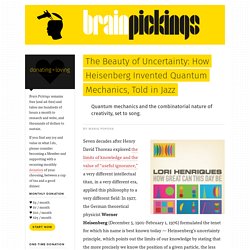
Uncertainty reigns over Heisenberg's measurement analogy. A row has broken out among physicists over an analogy used by Werner Heisenberg in 1927 to make sense of his famous uncertainty principle.
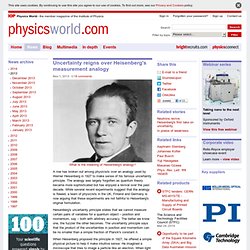
The analogy was largely forgotten as quantum theory became more sophisticated but has enjoyed a revival over the past decade. While several recent experiments suggest that the analogy is flawed, a team of physicists in the UK, Finland and Germany is now arguing that these experiments are not faithful to Heisenberg's original formulation. Heisenberg's uncertainty principle states that we cannot measure certain pairs of variables for a quantum object – position and momentum, say – both with arbitrary accuracy. Fluid Experiments Support Deterministic “Pilot-Wave” Quantum Theory. For nearly a century, “reality” has been a murky concept.
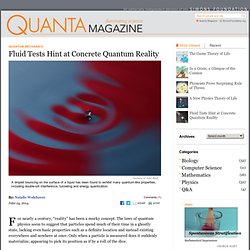
The laws of quantum physics seem to suggest that particles spend much of their time in a ghostly state, lacking even basic properties such as a definite location and instead existing everywhere and nowhere at once. Only when a particle is measured does it suddenly materialize, appearing to pick its position as if by a roll of the dice. This idea that nature is inherently probabilistic — that particles have no hard properties, only likelihoods, until they are observed — is directly implied by the standard equations of quantum mechanics. But now a set of surprising experiments with fluids has revived old skepticism about that worldview. The bizarre results are fueling interest in an almost forgotten version of quantum mechanics, one that never gave up the idea of a single, concrete reality.
Quantum Physics Made Relatively Simple: A Mini Course from Nobel Prize-Winning Physicist Hans Bethe. Higgs boson: Call to rename particle to acknowledge other scientists. 22 April 2013Last updated at 13:00 ET By Pallab Ghosh Science correspondent, BBC News "Fathers" of the Higgs, L-R: Francois Englert, Peter Higgs, Carl Hagen and Gerald Guralnik One of the scientists who helped develop the theory of the Higgs boson says the particle should be renamed.
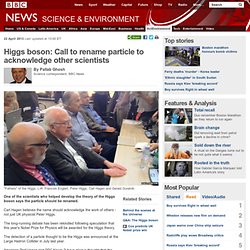
Carl Hagen believes the name should acknowledge the work of others - not just UK physicist Peter Higgs. The long-running debate has been rekindled following speculation that this year's Nobel Prize for Physics will be awarded for the Higgs theory. The detection of a particle thought to be the Higgs was announced at the Large Hadron Collider in July last year. American Prof Hagen told BBC News: "I have always thought that the name was not a proper one. Continue reading the main story “Start Quote Peter Higgs was treated as something of a rock star and the rest of us were barely recognised. End QuoteProf Carl HagenRochester University, New York Peter Higgs is open to a name change to "H Boson" Nobel Prize. Symphony of Science - the Quantum World! Bohr and beyond: a century of quantum physics › Opinion (ABC Science) In Depth › Analysis and Opinion Our understanding of the quantum world began with Niels Bohr's discovery of the quantum atom in 1913.
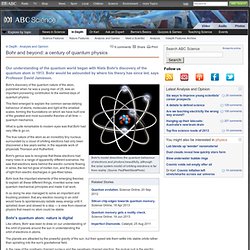
Bohr would be astounded by where his theory has since led, says Professor David Jamieson. Bohr's discovery of the quantum nature of the atom, published when he was a young man of 28, was an important pioneering contribution to the earliest days of quantum physics. This field emerged to explain the common sense-defying behaviour of atoms, molecules and light at the smallest scales, forming the foundations on which we have built one of the greatest and most successful theories of all time — quantum mechanics. What is quite remarkable to modern eyes was that Bohr had very little to go on. The true nature of the atom as an incredibly tiny nucleus surrounded by a cloud of orbiting electrons had only been discovered a few years earlier, in the separate work of physicists Thomson and Rutherford. ^ to top Bohr's quantum atom: nature is digital From theory to evidence.